
Eta Carinae, formerly known as Eta Argus, is a stellar system containing at least two stars with a combined luminosity greater than five million times that of the Sun, located around 7,500 light-years distant in the constellation Carina. Previously a 4th-magnitude star, it brightened in 1837 to become brighter than Rigel, marking the start of its so-called "Great Eruption". It became the second-brightest star in the sky between 11 and 14 March 1843 before fading well below naked-eye visibility after 1856. In a smaller eruption, it reached 6th magnitude in 1892 before fading again. It has brightened consistently since about 1940, becoming brighter than magnitude 4.5 by 2014.
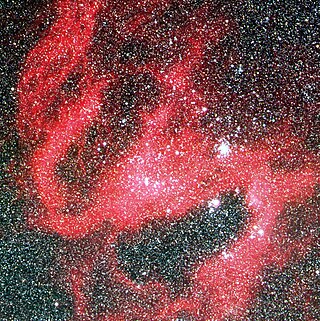
S Doradus is one of the brightest stars in the Large Magellanic Cloud (LMC), a satellite galaxy of the Milky Way, located roughly 160,000 light-years away. The star is a luminous blue variable, and one of the most luminous stars known, having a luminosity varying widely above and below 1,000,000 times the luminosity of the Sun, although it is too far away to be seen with the naked eye.

Luminous blue variables (LBVs) are massive evolved stars that show unpredictable and sometimes dramatic variations in their spectra and brightness. They are also known as S Doradus variables after S Doradus, one of the brightest stars of the Large Magellanic Cloud. They are extraordinarily rare, with just 20 objects listed in the General Catalogue of Variable Stars as SDor, and a number of these are no longer considered LBVs.

P Cygni is a variable star in the constellation Cygnus. The designation "P" was originally assigned by Johann Bayer in Uranometria as a nova. Located about 5,300 light-years from Earth, it is a hypergiant luminous blue variable (LBV) star of spectral type B1-2 Ia-0ep that is one of the most luminous stars in the Milky Way.
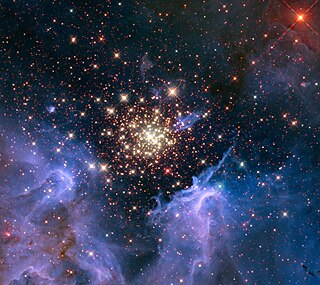
Sher 25 is a blue supergiant star in the constellation Carina, located approximately 25,000 light years from the Sun in the H II region NGC 3603 of the Milky Way. It is a spectral type B1Iab star with an apparent magnitude of 12.2. Its initial main sequence mass is calculated at 60 times the mass of the Sun, but a star of this type will have already lost a substantial fraction of that mass. It is unclear whether Sher 25 has been through a red supergiant phase or has just evolved from the main sequence, so the current mass is very uncertain.

NGC 2363 is a star-forming region in the Magellanic galaxy NGC 2366 which is located in the constellation Camelopardalis. It contains NGC 2363-V1, a luminous blue variable star which is 6,300,000 times more luminous than the Sun and one of the most luminous stars known. It can be seen in this Hubble Space Telescope image as the bright isolated star in the dark void on the left of the nebula.

SN 2006gy was an extremely energetic supernova, also referred to as a hypernova or quark-nova, that was discovered on September 18, 2006. It was first observed by Robert Quimby and P. Mondol, and then studied by several teams of astronomers using facilities that included the Chandra, Lick, and Keck Observatories. In May 2007 NASA and several of the astronomers announced the first detailed analyses of the supernova, describing it as the "brightest stellar explosion ever recorded". In October 2007 Quimby announced that SN 2005ap had broken SN 2006gy's record as the brightest-ever recorded supernova, and several subsequent discoveries are brighter still. Time magazine listed the discovery of SN 2006gy as third in its Top 10 Scientific Discoveries for 2007.
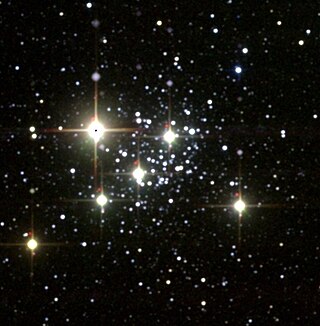
MY Cephei is a red supergiant located in open cluster NGC 7419 in the constellation of Cepheus. It is a semiregular variable star with a maximum brightness of magnitude 14.4 and a minimum of magnitude 15.5.

HD 97950, is a multiple star system and part of a super star cluster within the NGC 3603 H II region. It was catalogued as a single star although it was always known to be a compact cluster. It is now resolved into a massive multiple star at the centre of one of the densest clusters in the galaxy.

HR Carinae is a luminous blue variable star located in the constellation Carina. It is surrounded by a vast nebula of ejected nuclear-processed material because this star has a multiple shell expanding atmosphere. This star is among the most luminous stars in the Milky Way. It has very broad emission wings on the Balmer lines, reminiscent from the broad lines observed in the spectra of O and Wolf–Rayet stars. A distance of 5 kpc and a bolometric magnitude of -9.4 put HR Car among the most luminous stars of the galaxy.
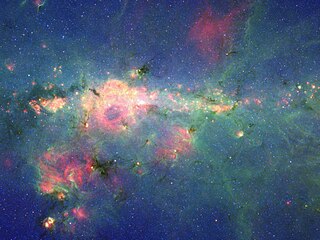
WR 102ka, also known as the Peony star, is a slash star that is one of several candidates for the most luminous-known star in the Milky Way.

A hypergiant (luminosity class 0 or Ia+) is a very rare type of star that has an extremely high luminosity, mass, size and mass loss because of its extreme stellar winds. The term hypergiant is defined as luminosity class 0 (zero) in the MKK system. However, this is rarely seen in literature or in published spectral classifications, except for specific well-defined groups such as the yellow hypergiants, RSG (red supergiants), or blue B(e) supergiants with emission spectra. More commonly, hypergiants are classed as Ia-0 or Ia+, but red supergiants are rarely assigned these spectral classifications. Astronomers are interested in these stars because they relate to understanding stellar evolution, especially star formation, stability, and their expected demise as supernovae.

Supernova impostors are stellar explosions that appear at first to be a supernova but do not destroy their progenitor stars. As such, they are a class of extra-powerful novae. They are also known as Type V supernovae, Eta Carinae analogs, and giant eruptions of luminous blue variables (LBV).

HD 5980 is a multiple star system on the outskirts of NGC 346 in the Small Magellanic Cloud (SMC) and is one of the brightest stars in the SMC.

IRC+10420, also known as V1302 Aql, is a yellow hypergiant star located in the constellation of Aquila at a distance of 4-6 kiloparsecs of the Sun.
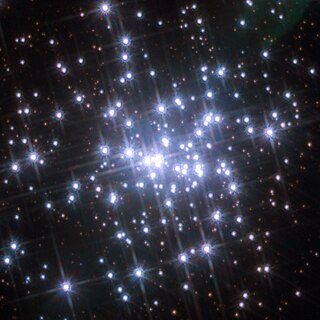
NGC 3603-C is a single-lined spectroscopic binary star system located at the centre of the HD 97950 cluster in the NGC 3603 star-forming region, about 25,000 light years from Earth. The primary has spectral type WN6h and is among the most luminous and most massive known.
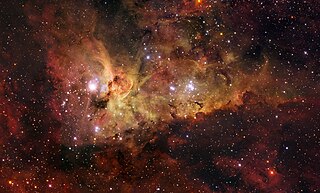
Trumpler 16 is a massive open cluster that is home to some of the most luminous stars in the Milky Way galaxy. It is situated within the Carina Nebula complex in the Carina–Sagittarius Arm, located approximately 9,270 ly (2,842 pc) from Earth. The cluster has one star visible to the naked eye from the tropics southward, Eta Carinae.
Carmelle Robert is a Quebec astrophysicist, starburst researcher and professor at the Department of Physics, Physical Engineering and Optics at Université Laval, in Quebec City, Quebec.
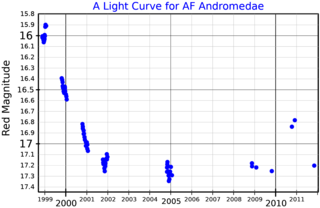
AF Andromedae is a luminous blue variable (LBV), a type of variable star. The star is one of the most luminous variables in M31, the Andromeda Galaxy.


















